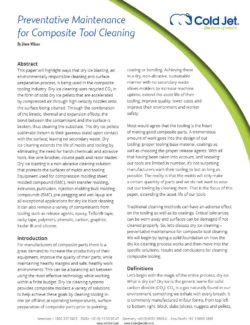Preventative Maintenance for Composite Tool Cleaning
Safely cleaning composite tooling with dry ice blasting
Dry ice blasting extends the life of composite molds and tooling by eliminating the need for harsh chemicals, wire brushes and coarse pads
This paper will highlight ways that dry ice blasting, an environmentally responsible cleaning and surface preparation process, is being used in the composite tooling industry. Dry ice cleaning uses recycled CO2 in the form of solid dry ice pellets that are accelerated by compressed air through high velocity nozzles onto the surface being cleaned. Through the combination of the kinetic, thermal and expansion effects, the bond between the contaminant and the surface is broken, thus cleaning the substrate. The dry ice pellets sublimate (return to their gaseous state) upon contact with the surface; leaving no secondary waste. Dry ice cleaning extends the life of molds and tooling by eliminating the need for harsh chemicals and abrasive tools, like wire brushes, course pads and razor blades.
Dry ice blasting is a non-abrasive cleaning solution that protects the surfaces of molds and tooling. Equipment used for compression molding sheet molded compound (SMC), resin transfer molding, extrusion, pultrusion, injection molding bulk molding compounds (BMC), pre-pregging and wet-layup are all exceptional applications for dry ice blast cleaning. It can also remove a variety of contaminants from tooling such as release agents, epoxy, Teflon® tape, tacky tape, polymers, phenolic, carbon, graphite, Kevlar ® and silicone.
